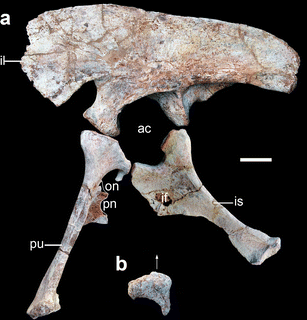A restoration of Ichthyovenator laosensis
by Michel Fontaine. From Allain et al., 2012.
Abstract
Spinosaurids are among the largest and most specialized carnivorous dinosaurs. The morphology of their crocodile-like skull, stomach contents, and oxygen isotopic composition of the bones suggest they had a predominantly piscivorous diet. Even if close relationships between spinosaurids and Middle Jurassic megalosaurs seem well established, very little is known about the transition from a generalized large basal tetanuran to the specialized morphology of spinosaurids. Spinosaurid remains were previously known from the Early to Late Cretaceous of North Africa, Europe, and South America. Here, we report the discovery of a new spinosaurid theropod from the late Early Cretaceous Savannakhet Basin in Laos, which is distinguished by an autapomorphic sinusoidal dorsosacral sail. This new taxon, Ichthyovenator laosensis gen. et sp. nov., includes well-preserved and partially articulated postcranial remains. Although possible spinosaurid teeth have been reported from various Early Cretaceous localities in Asia, the new taxon I. laosensis is the first definite record of Spinosauridae from Asia. Cladistic analysis identifies Ichthyovenator as a member of the sub-clade Baryonychinae and suggests a widespread distribution of this clade at the end of the Early Cretaceous. Chilantaisaurus tashouikensis from the Cretaceous of Inner Mongolia, and an ungual phalanx from the Upper Jurassic of Colorado are also referred to spinosaurids, extending both the stratigraphical and geographical range of this clade.
Keywords: Cretaceous, Savannakhet basin, Theropoda, Spinosauridae, Asia
Allain, R., Xaisanavong, T., P. Richir and Khentavong, B. (In press). The first definitive Asian spinosaurid (Dinosauria: Theropoda) from the Early Cretaceous of Laos. Naturwissenschaften (advance online publication) http://dx.doi.org/10.1007/s00114-012-0911-7
illustration: http://www.michel-fontaine.com/illustrations.html
Fig. 1 Twelfth dorsal vertebra (BK 10-01) of I. laosensis.
Fig. 2 Reconstruction and morphology of the sinusoidal dorsosacral sail of the holotype of I. laosensis (MDS BK10-01 to BK10-08).
Fig. 4 Pelvis of the holotype of I. laosensis.
Spinosauridae Stromer 1915
Baryonychinae Charig and Milner 1986
Ichthyovenator laosensis gen et sp nov.
Etymology : The generic name is derived from ichthos (ancient Greek word for fish), and from venator (Latin word for “hunter”). The generic name is in reference to the predominantly piscivorous diet of Spinosauridae. The specific name is derived from the name Laos.
Holotype : Partially articulated skeleton, curated at the Dinosaur Museum, Savannakhet (MDS BK10-01 to 15), including the antepenultimate dorsal vertebra, the neural spine of the last dorsal vertebra, the first and the second caudal vertebrae, five incomplete sacral vertebrae found in articulation, ilia, the right pubis, ischia, and a posterior dorsal rib (Figs. 1, 2. 3 and 4) (See ESM, for a complete description of the bones).
mission DinOsavan 2012 au Laos
Fig. 5: Time-calibrated result of the phylogenetic analysis showing the interrelationships of I. laosensis within theropoda. Numerous synapomorphies place Ichthyovenator within the Baryonychinae as the sister-group of (Suchomimus + Baryonyx).
http://blogs.smithsonianmag.com/dinosaur/2012/04/ichthyovenator-the-sail-backed-fish-hunter-of-laos/










